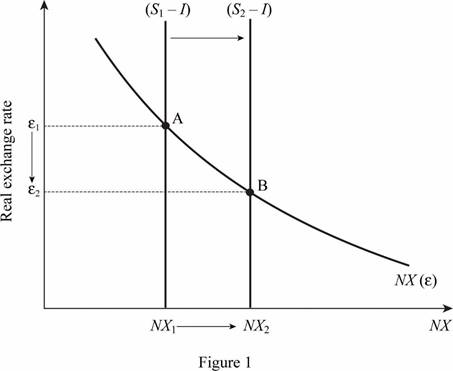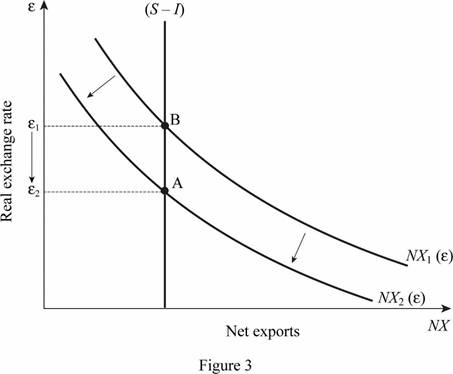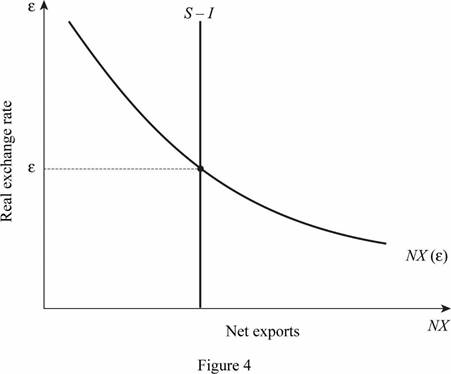
Subpart (a):
Changes in the trade balance, real exchange rate, and nominal exchange rate.
Subpart (a):
Explanation of Solution
The fall in consumer confidence about the future induces the following effect on the trade balance, real exchange rate, and the nominal exchange rate which is depicted in figure 1.

In figure 1, the horizontal axis measures the net exports (trade balance) and the vertical axis measures the real exchange rate.
When the consumer spends less and save more, the
Nominal exchange rate: Nominal exchange rate can be defined as the relative price of currencies of two countries that is the rate at which one currency can be exchanged for another currency.
Real exchange rate: Real exchange rate can be defined as the relative price of goods or services of two countries, which is the rate at which one can exchange the goods and services of one country for the goods and services of another.
Inflation: Inflation is the situation of abnormal price hike in the economy which leads to the situation of too much money chasing less number of goods.
Depreciation of currency: The depreciation of currency implies decrease in the value of currency of respective country.
Appreciation of currency: The appreciation of currency implies increase in the value of currency of that country.
Subpart (b):
The changes in the trade balance, real exchange rate and nominal exchange rate.
Subpart (b):
Explanation of Solution
The tax reform induces the following effect on trade balance, real exchange rate, and the nominal exchange rate which is depicted in figure 2.

In figure 2, the horizontal axis measures the net exports (trade balance) and the vertical axis measures the real exchange rate.
The tax reform induces business to build factories and this increase the investment, which shifts the
Nominal exchange rate: Nominal exchange rate can be defined as the relative price of currencies of two countries that is the rate at which one currency can be exchanged for another currency.
Real exchange rate: Real exchange rate can be defined as the relative price of goods or services of two countries, which is the rate at which one can exchange the goods and services of one country for the goods and services of another.
Inflation: Inflation is the situation of abnormal price hike in the economy which leads to the situation of too much money chasing les number of goods.
Depreciation of currency: The depreciation of currency implies decrease in the value of currency of respective country.
Appreciation of currency: The appreciation of currency implies increase in the value of currency of that country.
Subpart (c):
The changes in the trade balance, real exchange rate, and nominal exchange rate.
Subpart (c):
Explanation of Solution
The consumer prefers foreign cars over domestic cars induces the following effect on the trade balance, real exchange rate, and the nominal exchange rate which is depicted in figure 3.

In figure 3, the horizontal axis measures the net exports (trade balance) and the vertical axis measures the real exchange rate.
The consumers’ preference for foreign cars over the domestic cars would have no effect on the savings and investment and therefore, there is no shift in
Nominal exchange rate: Nominal exchange rate can be defined as the relative price of currencies of two countries that is the rate at which one currency can be exchanged for another currency.
Real exchange rate: Real exchange rate can be defined as the relative price of goods or services of two countries, which is the rate at which one can exchange the goods and services of one country for the goods and services of another.
Inflation: Inflation is the situation of abnormal price hike in the economy which leads to the situation of too much money chasing less number of goods.
Depreciation of currency: The depreciation of currency implies decrease in the value of currency of respective country.
Appreciation of currency: The appreciation of currency implies increase in the value of currency of that country.
Subpart (d):
The changes in the trade balance, real exchange rate, and nominal exchange rate.
Subpart (d):
Explanation of Solution
Doubling the money supply induces the following effect on trade balance, real exchange rate, and the nominal exchange rate which is depicted in figure 4.

In figure 4, the horizontal axis measures the net exports (trade balance) and the vertical axis measures the real exchange rate.
Output Y is determined by the amount of capital and labor, whereas the investment I(r*) is determined by the world interest rate (r*). The net export (NX), on the other hand, is determined by the difference in domestic saving and domestic investment
Doubling the money supply has no effect on any real variables by the money neutrality. However, it affects the nominal exchange rate through its effect on the domestic price level P.
Price level P adjusts to equilibrate the demand for supply of real balances which is given as follows:
The level of output and the interest rate determines the real money demand
The nominal exchange rate is given as follows:
It can be expressed as follows:
Where e is the nominal exchange rate,
Nominal exchange rate: Nominal exchange rate can be defined as the relative price of currencies of two countries that is the rate at which one currency can be exchanged for another currency.
Real exchange rate: Real exchange rate can be defined as the relative price of goods or services of two countries, which is the rate at which one can exchange the goods and services of one country for the goods and services of another.
Depreciation of currency: The depreciation of currency implies decrease in the value of currency of respective country.
Appreciation of currency: The appreciation of currency implies increase in the value of currency of that country.
Subpart (e):
The changes in the trade balance, real exchange rate and nominal exchange rate.
Subpart (e):
Explanation of Solution
Increase in the demand for money induces the following effect on trade balance, real exchange rate, and the nominal exchange rate.
Output Y is determined by the amount of capital and labor, whereas investment I(r*) is determined by the world interest rate (r*). The net export (NX), on the other hand, is determined by difference in domestic saving and domestic investment
The increase in demand for money has no effect on any real variables by the money neutrality. However, it affects the nominal exchange rate through its effect on the domestic price level P.
Price level P adjusts to equilibrate the demand for supply of real balances which is given as follows:
The level of output and the interest rate determines the real money demand
The nominal exchange rate is given as follows:
It can be expressed as follows:
Here, e is the nominal exchange rate,
Nominal exchange rate: Nominal exchange rate can be defined as the relative price of currencies of two countries that is the rate at which one currency can be exchanged for another currency.
Real exchange rate: Real exchange rate can be defined as the relative price of goods or services of two countries, which is the rate at which one can exchange the goods and services of one country for the goods and services of another.
Depreciation of currency: The depreciation of currency implies decrease in the value of currency of respective country.
Appreciation of currency: The appreciation of currency implies increase in the value of currency of that country.
Want to see more full solutions like this?
Chapter 6 Solutions
MACROECONOMICS+SAPLING+6 M REEF HC>IC<
- If foreign investors buy more U.S. stocks and bonds, how would that show up in the current account balance?arrow_forwardIf the trade deficit of the United States increases, how is the current account balance affected?arrow_forwardThe GDP for the United States is 18,036 billion and its current account balance is 484 billion. What percent of GDP is the current account balance?arrow_forward
- Imagine that the economy of Germany finds itself in the following situation: the government budget has a surplus of 1 of Germanys GDP; private savings is 20 of GDP; and physical investment is 18 of GDP. Based on the national saving and investment identity, what is the current account balance? If the government budget surplus falls to zero, how will this affect the current account balance?arrow_forwardWhy does the trade balance and the current account balance track so closely together over time?arrow_forward
 Macroeconomics: Private and Public Choice (MindTa...EconomicsISBN:9781305506756Author:James D. Gwartney, Richard L. Stroup, Russell S. Sobel, David A. MacphersonPublisher:Cengage Learning
Macroeconomics: Private and Public Choice (MindTa...EconomicsISBN:9781305506756Author:James D. Gwartney, Richard L. Stroup, Russell S. Sobel, David A. MacphersonPublisher:Cengage Learning Economics: Private and Public Choice (MindTap Cou...EconomicsISBN:9781305506725Author:James D. Gwartney, Richard L. Stroup, Russell S. Sobel, David A. MacphersonPublisher:Cengage Learning
Economics: Private and Public Choice (MindTap Cou...EconomicsISBN:9781305506725Author:James D. Gwartney, Richard L. Stroup, Russell S. Sobel, David A. MacphersonPublisher:Cengage Learning Brief Principles of Macroeconomics (MindTap Cours...EconomicsISBN:9781337091985Author:N. Gregory MankiwPublisher:Cengage Learning
Brief Principles of Macroeconomics (MindTap Cours...EconomicsISBN:9781337091985Author:N. Gregory MankiwPublisher:Cengage Learning Principles of Economics 2eEconomicsISBN:9781947172364Author:Steven A. Greenlaw; David ShapiroPublisher:OpenStax
Principles of Economics 2eEconomicsISBN:9781947172364Author:Steven A. Greenlaw; David ShapiroPublisher:OpenStax Principles of Economics (MindTap Course List)EconomicsISBN:9781305585126Author:N. Gregory MankiwPublisher:Cengage Learning
Principles of Economics (MindTap Course List)EconomicsISBN:9781305585126Author:N. Gregory MankiwPublisher:Cengage Learning Principles of Macroeconomics (MindTap Course List)EconomicsISBN:9781305971509Author:N. Gregory MankiwPublisher:Cengage Learning
Principles of Macroeconomics (MindTap Course List)EconomicsISBN:9781305971509Author:N. Gregory MankiwPublisher:Cengage Learning





